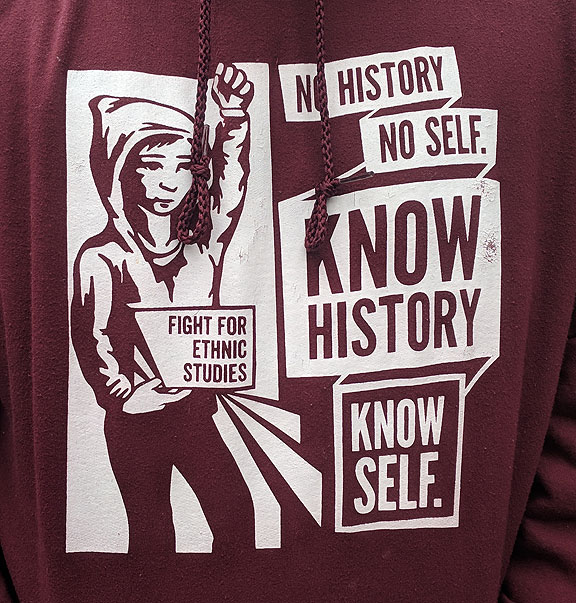
Sweatshirt for the Ethnic Studies College at San Francisco State University, created in the wake of the 1968 student/faculty strike.
After the most recent mass shooting in Florida, the sudden emergence of articulate teenagers demanding gun control laws has been inspiring. It is impossible not to also notice that their platform has been amplified by widespread media coverage in a way that the protests against day-to-day violence perpetrated by police in San Francisco and the rest of the cities of the U.S. is not. This past Thursday, thousands of angry protesters blocked the Interstate and then the local sports arena in Sacramento after police murdered an unarmed young African American father in his grandmother’s backyard. An egregious mistake, clearly, but one all too easily normalized in the police state we live in. Only a couple of weeks ago a 19-year-old Latino was killed in a hail of bullets poured into the trunk of a car where he was hiding—just a few blocks from my home—fearing that if apprehended he might be deported to a Mexico he never knew (he was part of an undocumented family).
While the bodies pile up around the country thanks to out-of-control police, crazed white men with too many guns, and the everyday mayhem imposed by a fraying society that leaves so many isolated and desperate, it’s easy to overlook the elephant in the room. The United States is a huge war machine. As Andrew Bacevich aptly laid it out in a recent open letter to the New York Times, we’re practically two decades into a war with no name, no apparent strategic goal, and no acknowledgment of its actual cost ($7 trillion and counting). It spreads across multiple countries (mostly in the greater Middle East, but increasingly popping up in Africa and other parts of Asia too) and has already led to devastating destruction in Iraq, Syria, Libya, Somalia, Afghanistan, and with the appointment of war criminal and madman John Bolton as new National Security Advisor more war, not less, is squarely on the agenda.
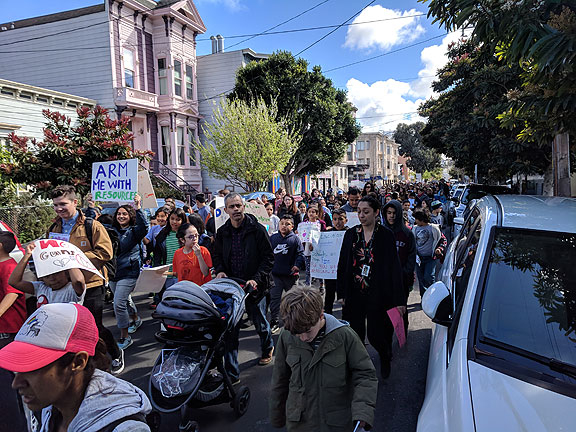
On March 14 students walked out from schools across San Francisco and the country…. these are Horace Mann students with families and faculty…
With all due respect and enthusiasm for the teenage campaign for gun control, we aren’t going to reproduce the Australian experience, where a mass shooting led to the massive disarming of the society along with strict legal limits on guns. Background checks, waiting periods, etc. won’t disarm the country. The 2nd Amendment itself must be repealed before any meaningful disarmament can take place. The 3% of the country that owns 50%+ of the guns isn’t going to give up their arms without using them first. The deep psychological commitment to arms has historical roots that were briefly brought to the surface during the spate of Confederate monument removals. The white racists in this society built those monuments to rewrite the history of the Civil War. Though they lost the war and don’t completely control the historical narrative, they’ve had remarkable success during a century of ongoing racist domination and plunder. The use of weapons by private citizens in this age-old racist order is one of its central characteristics.
Writing in her most recent book Loaded: A Disarming History of the Second Amendment (City Lights Books: San Francisco, 2018), Roxanne Dunbar-Ortiz dismisses the empty debate between the NRA and its opponents over the true meaning of the 2nd Amendment. She agrees that the 2nd Amendment guarantees a personal right to arms, but wants to recover the history of the time in which such a right would be declared:
Any assessment of gun violence and the Second Amendment in the United States is incomplete or skewed without dealing with what the guns were for, and, given what they were for, what that means about their popularity and proliferation today. The United States created its armed forces and police to carry out a genocidal policy against Native peoples, seize Native land, and control African Americans, which continues to this day in other forms, including police shooting unarmed Black men and incarcerating a large percentage of them. In the process, the United States has invented enemies and spent hoards of wealth to erect the largest military force in history, including a vast network of hundreds of military bases in more than seventy countries and territories around the globe. (p. 194)
Our culture is obsessed with spectacular violence, from video games to popular movies. Sports events open with the tedious national anthem, often adding in salutes to honor “our Armed Forces” as though the murderous violence they carry out in far-off countries was somehow noble or ethical. Few Americans even bother to think about what it might be like to be aerially bombarded, even when they stand and watch flyovers of the Blue Angels and other military aircraft during organized festivals of pro-military propaganda like Fleet Week here in the SF Bay Area, or national holidays like Memorial Day or the Fourth of July. But as Roxanne asks in her book, why is there such a deep commitment to this martial culture, why do Americans identify so much with militarism and armed violence? To answer this we have to go deep into the national history, unpacking the myths of the frontier and the false idea of an inevitable spread of civilization against more primitive cultures.
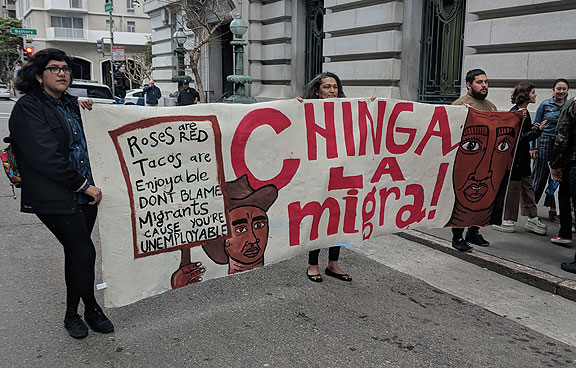
February 28 2014 blockade of ICE offices in downtown San Francisco after raids around northern California.
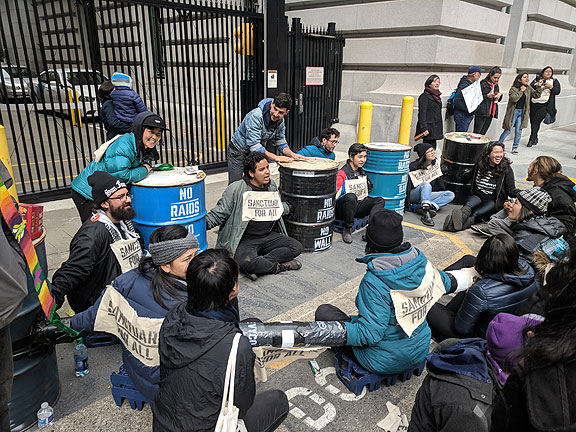
Lockdown blockade, Feb. 28, 2018
Going back into history is of course quite purposeful. I don’t mean to just repeat the common platitudes and regurgitate the self-congratulatory myths that led us to the self-satisfied present. I take a cue from Peter Norton, a historian whose great work Fighting Traffic unpacks how the urban streets came to be dominated by “motordom” in the 1910s and 1920s. Peter spoke at the World Bike Forum in Lima the night before I did and urged us all to rethink the typical linearity of history–>present–>future. Instead of accepting that this world we inhabit is the inevitable result of a specific past (as told by those who benefit from today’s status quo for the most part) he encouraged us to rethink that past, uncover the lost threads that weave a very different story about how the world got this way, and by doing so, provide the foundation for a different trajectory towards an entirely different and more hopeful future. That is precisely the spirit in which I am writing this essay, and which has informed my ongoing work at Shaping San Francisco all these past 20+ years. When we repeat our motto “History is a creative act in the present” we don’t mean we make up history out of whole cloth, but that we use our creative and critical faculties to understand history in all its complexity, to interpret it anew, and to shape our present and future in the act of “making history.” In writing about how digital technologies are shaping our sense of meaning, memory and ultimately our future, Abby Smith Rumsey (When We Are No More: How Digital Memory Is Shaping Our Future, Bloomsbury Press: New York, 2016) delves into recent neurological science to track what we’ve learned about how memory works, which is vital because as she says at the outset, “memory is not about the past. It is about the future.” (p. 12)
Because every memory is tweaked and fortified in use, we live in a state of nonstop historical reinterpretation. The upshot is that the past itself changes in the process of remembering. The representation of things that were laid down previously—whether five decades ago or five minutes—are modified simply by being used. In use, they are placed within the environment of the present moment and that use becomes an intrinsic part of memory itself—the past plus. (p. 114) … The tale of progress from ignorance to enlightenment follows the same plotline as the narrative from sin to salvation. This is a distinctly Western perspective, quite different from the cyclical view of time typical of Hindu and Buddhist world views. But it is the one that undergirds the global language of digital memory. (p. 106)
A great deal of our “automatic” historical consciousness is simply wrong. The arc Rumsey describes above is deeply embedded in the assumptions we have about “where we are” in history (obviously, the most civilized, most developed, richest, happiest, best of all possible societies, in the best country of the world, ever!). Many Americans will shut down or get quite upset if you question this absurdist self-conception. But even many on the lefty-liberal end of the spectrum won’t challenge the longer arc from pre-historical hunter-gatherer cultures to the rise of agriculture and the city-state, and eventually the modern nation state. And that’s where an amazing new book by James C. Scott (Against the Grain: A Deep History of the Earliest States, Yale University Press: New Haven, CT, 2017) enters the discussion. In a nutshell, he argues against the common narrative arc that says primitive peoples digging in the mud were superceded by superior methods of food production centered on early grain agriculture and animal husbandry. Rather, he convincingly argues that early human settlements tended to develop on wetlands (he is focused on the rich Mesopotamian lands in today’s Iraq and Iran) and that they thrived and lasted for hundreds of years, interacting and trading with more hierarchical statist societies, before the modern states finally eliminated the autonomous zones in which these alternative systems of life persisted.
Aside from the utter hegemony of the state form today, a great deal of archaeology and history throughout the world is state-sponsored and often amounts to a narcissistic exercise in self-portraiture. Compounding this institutional bias is the archaeological tradition, until quite recently, of excavating and analysis of major historical ruins. Thus if you built, monumentally, in stone and left your debris conveniently in a single place, you were likely to be “discovered” and to dominate the pages of ancient history. (p. 13)
… the earliest large fixed settlements sprang up in wetlands, not arid settings; they relied overwhelmingly on wetland resources, not grain, for their subsistence; and they had no need of irrigation in the generally understood sense of the term…(p. 47) The inhabitants of these marshes lived on what are called “turtlebacks,” small patches of slightly higher ground, comparable to cheniers in the Mississippi delta, often no more than a meter or so above the high-water mark. From these turtlebacks, inhabitants exploited virtually all the wetland resources within reach: reeds and sedges for building and food, a great variety of edible plants (club rush, cattails, water lily, bulrush), tortoises, fish, mollusks, crustaceans, birds, waterfowl, small mammals, and migrating gazelles that provided a major source of protein. The combination of rich alluvial soils with an estuary of two great rivers teeming with nutrients, dead and alive, made for an exceptionally rich riparian life that in turn attracted huge numbers of fish, turtles, birds, and mammals—not to mention humans!–preying on creatures lower on the food chain. (p. 50)
Of course I found this description incredibly rich and revealing. The San Francisco Bay Area, once a third larger than it is today was an incredibly rich wetland landscape that may have supported the largest pre-contact population in North America. The pre-Spanish, pre-European history has only been revealed through excavating shellmounds and middens and exploring the compromised oral histories taken long after the initial shock of encounter. (For an excellent contemporary discussion of local Ohlone cultural history and the fight over the Berkeley Shellmound, listen to the most recent episode of East Bay Yesterday.) But nearly everything Scott says about the cultures that thrived for millennia in Mesopotamia applies perfectly to the Bay Area.
The Spanish and then the Mexican-Californio culture that predated the seizure by the Americans in the 1846-48 war was largely based on cattle and suppression of the fires that native populations had used forever to create their rich and abundant landscape. The effects of domestic livestock on the hills and valleys of the area were dramatic, but not as dramatic as the sudden arrival of tens of thousands of people in the Gold Rush. The frenzy to “make land” during those early years, cutting down hills and dunes and pushing the debris into the shallow mudflats along the shore, correspond closely to Scott’s description of how states evolved.
The work of civilization, or more precisely the state, as we shall see, consists in the elimination of mud and its replacement by its purer constituents, land and water. Whether in ancient China, in the Netherlands, in the fens of England, in the Pontine Marshes finally subdued by Mussolini, or in the remaining southern Iraq marshes drained by Saddam Hussein, the state has endeavored to turn ungovernable wetlands into taxable grain fields by reengineering the landscape… The wetland origins of population settlement have remained relatively invisible for other reasons as well. We are, after all, dealing here with largely oral cultures that left no written records for us to consult. Their relative obscurity is often magnified by the perishable nature of their building materials: reeds, sedges, bamboo, wood, rattan. (p. 56-57)
The wetlands produced wealth and towns but no states until more than a millennium later. Unlike a landscape of plough agriculture, the exuberant diversity of livelihoods in the wetlands was not favorable to state making. (p. 127) … In one way or another, nongrain peoples—that is to say most of the world—embodied forms of livelihood and social organization that defeated taxation: physical mobility, dispersal, variable group and community size, diverse and invisible subsistence goods, and few fixed-point resources. (p. 136)
The received, “automatic” history we carry, in which superior forms of life eliminated inferior forms, is simply a self-justifying myth that excuses barbaric murder, torture, and genocidal wars going back generations. In the case of the United States it starts well before independence from England when the Puritans were still huddled in their ascetic wooden villages in the harsh New England climate of the 1670s, surrounded by numerous healthy, dynamic cultures with whom they traded and depended on for survival. Due to their mentality, in which non-Christian peoples were subhuman, and anyone who didn’t put a fence around their private property and “improve” it by cutting down trees and engaging in sedentary agriculture therefore had no “legitimate” claim to the land, the Puritans of Massachusetts and Rhode Island kept encroaching on the land of the surrounding tribes. Finally, after several decades of continual violations of agreements about boundaries, the Indians had enough. The long-forgotten “King Philip’s War” of 1675-77 came very close to driving the Puritans out of New England (“King Philip” was the name given by the colonists to—and used by—Metamora, the Wampanoag leader). In her masterful work The Name of War: King Philip’s War and the Origins of American Identity (Vintage Books, Random House: New York, 1998) Jill Lepore not only describes the events of that time, but ponders deeply about how we know that history and how that history changed over time and took on different meanings in American history.
But she starts at the beginning, when English settlers (who by contemporary standards would be psychopathic in their weird combination of religiosity and biblical literalism combined with ascetic behavioral norms) were consumed with anxiety over maintaining their status as “civilized English” in a world where everyone was adapting and becoming more and more similar to the thousands of “savages” who lived in the surrounding country. During the early years of English settlement in New England the colonists were not only concerned with assimilating into Indians, but also they were intent on avoiding the well-documented atrocities known to have been committed by the Spanish in Mexico and Peru. A key element of that English identity was the role of private property.
With the development of capitalist markets in the sixteenth and seventeenth centuries, private property had become increasingly important, and revolts against this change, like the Digger protests of the 1640s and 1650s, were met with violent censure. Gradually property became the definiing character of social relations, the defining character, even, of an individual’s identity… The Algonquians’ perceived nomadism, and their failure to “improve” the land, formed the basis for English land claims. New England, John Winthrop argued, was a vacuum domicilum, since, only land that is fenced in, tilled, and built upon can be owned. Indians could not own the land, “for they inclose no ground, neither have they cattell to maintayne it, but remove their dwellings as they have occasion.” (p. 76-77)
English possessions were, in a sense, what was at stake in the war, for these—the clothes they wore, the houses they lived in, and the things they owned—were a good part of what differentiated the English from the Indians. These were not simply material differences, they were cultural, for every English frock coat was stitched with threads of civility, each thatched roof rested on a foundation of property rights, and every cupboard housed a universe of ideas… Left naked, English bodies and English land were no longer recognizable—naked men, after all, were barbarians, and naked land a wilderness. It was, in fact, the “nakedness” of America and of its native peoples—signaling the land’s vacancy and the Indians’ savagery—that had made English colonization possible in the first place… If the principal cultural anxiety behind King Philip’s War was confusion of identity (would Englishmen degenerate into Indians?), then the colonists must have taken heart that one thing, at least, seemed more clear than others. One boundary, at least, was rarely broached: even if some Indians sometimes wore clothes, Englishmen and -women were never publicly naked. (p. 79-81)
Finding themselves pushed back to their larger settlements after Indian attacks killed hundreds and destroyed dozens of farms and smaller villages, the Puritans embarked on a strategy that embraced a savagery they had previously assumed was beyond their capacity. They attacked the corn fields and camps of the Indians, avoiding direct battle with warriors in favor of slaughtering women and children and eliminating the sources of sustenance. With allied Indians they participated in torture and dismemberment and put the heads of their slain foes on poles where they sat for months. Militias were sent to “punish” local Indians and rewards were established for each kill. This in turn led to the practice of scalping, since they were much easier to transport than full bodies to gain the bounties. Overlooked in most histories of wars between settlers and Indians is the self-perpetuating crescendo of violence that the wars produced, leading to ever more horrifying and pointless massacres.
By the end of the war (a war that the Wampanoags and the Narragansetts and other nearby tribes didn’t ultimately win due to pressure on their western frontier from hostile Mohawks), the colonists’ territory had diminished and they lost many people and farms, but they had not been driven into the sea.
Questions about the sovereignty of Indian peoples and the legitimacy of English land claims had been more avoided than answered, and, most distressingly, the colonists’ fears about “degenerating” into Indians had only been exacerbated by their own “savage” conduct in the war. The incompleteness of the colonists’ victory meant that preserving the memory of the war, and preserving a particular kind of memory, one that depicted Philip as a barbarous villain, became as desperately critical to the colonists’ sense of themselves as waging the war had been in the first place. (p. 175)
Language, in this story, may have been the final marker of Englishnness. Like so many chroniclers of the war, Goodwife Thurston may have told her tale both as a way of making sense of her experience and as a way of reclaiming her identity. If the colonists’ Englishness had been compromised before the war by becoming more Indian in their ways, it was further compromised during the war by the loss of their homes and clothes and, most of all, by their killing mercilessly and abandoning the codes of “civil nations.” By telling about the war, and most especially by writing about it, the colonists could reclaim civility, could clothe their naked war with words. The writing itself would “dress” the English back up; it would undo the damage of the war by making clear once again who was English and who was Indian, and what made a massacre and what a victory. All of this depended, however, on denying the possibility that the Indians might themselves “dress” the war with their own words. (p. 94)
Curiously, after the writings of the Puritan colonists went to great lengths to justify their war and its outcome, in the early 1800s a play was commissioned about Metamora which embraced the Wampanoags’ cause as a properly American one. It was the beginning of a long process of romanticizing peoples who were supposedly gone forever and claiming their authenticity as something that was genuinely part of the American character.

ICE demo, Feb. 28, 2018
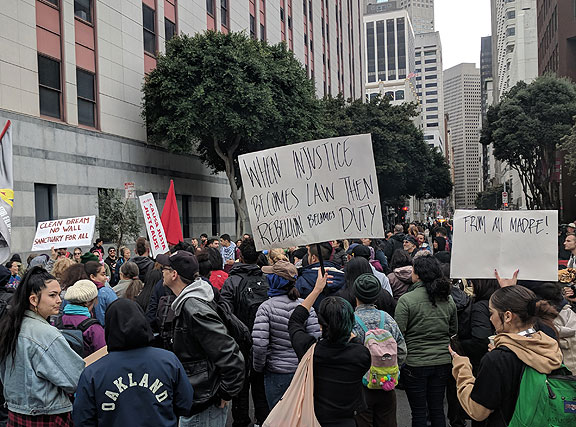
ICE demo, Feb. 28 2018

March 14 student walkout in Civic Center.
In fact, what had begun around the time of King Philip’s War was what military historian John Grenier has named “The First Way of War” (The First Way of War: American War Making on the Frontier, Cambridge University Press: New York, 2005) This type of total war is the actual foundation of the U.S. character, its military, and its militaristic and violent culture.
Americans combined the lessons of a century’s worth of experience with extirpative war, ranging, and scalp hunting into a single way of war. That first way of war, forged in the foundry of the seventeenth- and early-eighteenth-century’s Indian wars, shaped American war making well into the nineteenth century. It is therefore with some irony that Thomas Jefferson, at the end of the colonial era’s Indian conflicts, attributed the killing of innocent men, women and children solely to “savage” Indians. (p. 52)
In fact, by the time of the American Revolution against the British, the First Way of War had been honed by over a hundred years of expansion and aggressive war against tribes who lands were wanted by American settlers. Some even say that the treaty of 1763 signed by King George III with various Indian tribes to set the western boundary of the British colonies at the Appalachian mountains was the first strong indication to American colonists that their interests (westward expansion and further land grabs) were diverging from the British crown. The Revolutionary War turned out to be a disaster for the people of the Ohio River valley. The Shawnees were the main tribe to resist western expansion by the Americans during and after the war. They successfully defeated continental armies during the war and later U.S. troops by President George Washington, “forcing” the Americans to turn back to their well-developed first way of war, the brutal and unrestrained violence directed against the villages, fields, and food supplies of the Indians in their home country. Grenier points out that you could argue that the Indian wars that culminated in the 1810s were the end of a half-century war for Indian independence from the Americans.
Grenier cites D.H. Lawrence where he argues that if there is something “essentially” American in the frontier experience,
then there also seems truth, especially in terms of the centrality of the first way of war and the extravagant violence it engendered in the conquest of that frontier, to [Lawrence’s] assessment that “the essential American soul” is a killer… violence directed systematically against noncombatants through irregular means, from the start, has been a central part of Americans’ way of war. American soldiers have turned to it out of military necessity, economic need, and the search for social legitimization. (p. 222-224)
That brings us back to the starting point. I would love to imagine that a majority of people in this country would overthrow the brutal racists who are running the show. I’d love to see a radical reconceptualization of what the role of the state is and how it relates to a directly democratic society that is rooted in compassion and empathy. I’d especially love to see the radical reduction of the U.S. military and police, the elimination of U.S. military bases around the world and domestic prison abolition,and the redirection of all that wealth into making a good life for everyone—not just in the U.S. but across the world. The amount of human effort and wealth we spend on death and destruction and imprisonment is staggering. The domestic “collateral damage” of mass killings, police murders, and the daily fear and loathing that produces so much violence can be overcome, but not if we don’t take on the deeper history and cultural imperatives that are rooted in centuries of genocide and oppression.
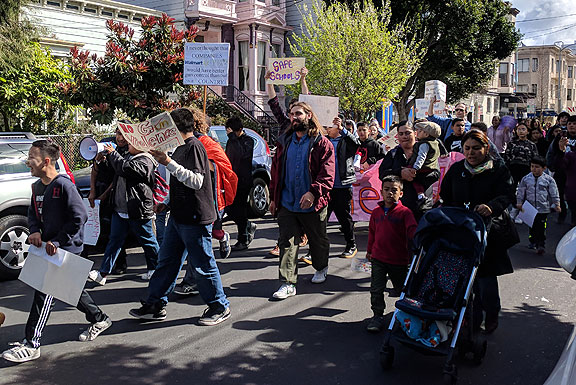
Horace Mann students on Bartlett, March 14 student walkout
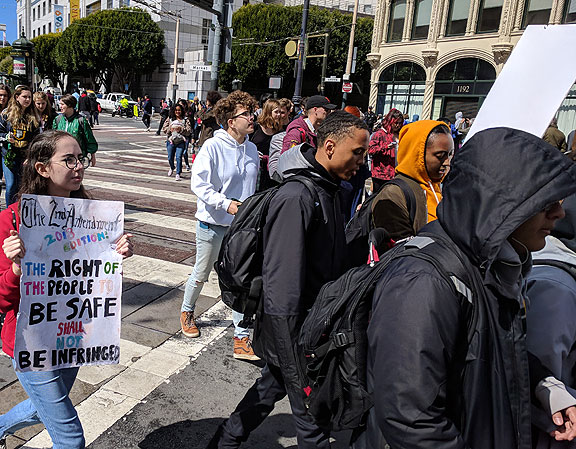
March 14 walkout
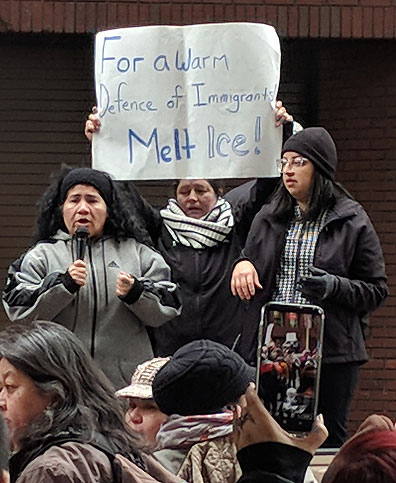
Feb 28 ICE blockade
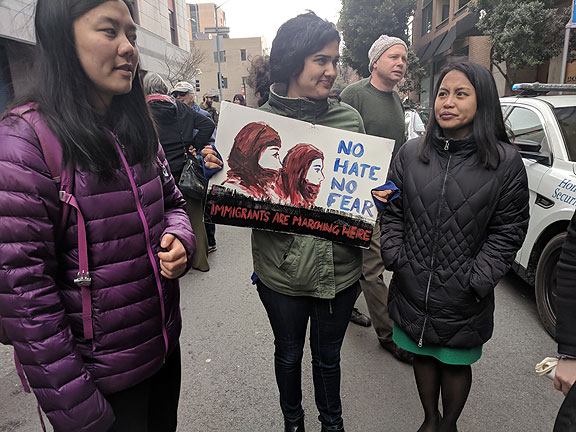
ICE blockade
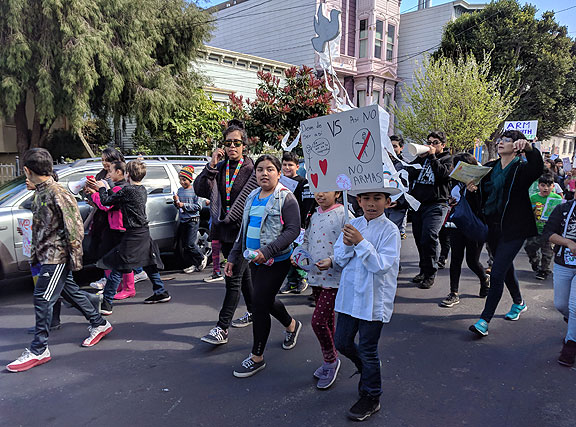
Horace Mann students
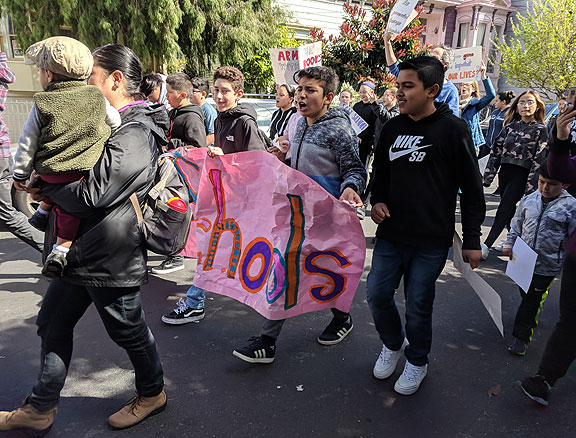
Horace Mann students and family
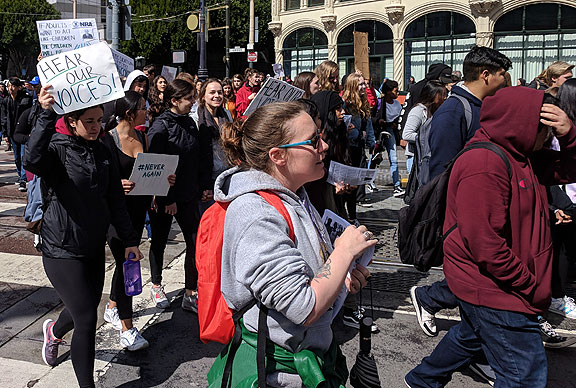
Market street marchers
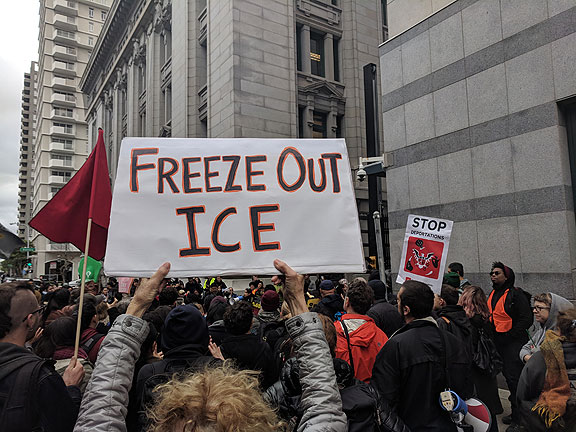
ICE blockade
Last word goes to Bill Ayers who has a handy manifesto out called Demand the Impossible: A Radical Manifesto (Haymarket Books: Chicago IL, 2016):
“In the empire of lies, every truth-teller is a traitor; in the United States of Amnesia, memory is the first casualty.”












Leave a Reply